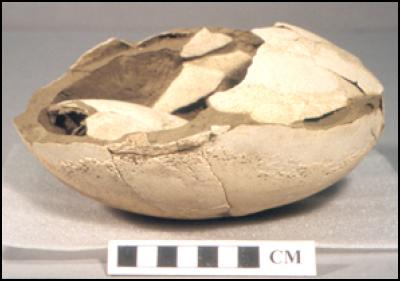Unscrambling Moa Eggs - Dads Kept The Eggs Warm
Unscrambling Moa Eggs - Dads Kept The Eggs Warm And Tried Not To Break Them

One of the moa eggs used in the research
Males of the now-extinct moa appear to have been stay-at-home dads responsible for keeping the eggs warm and, with some of the most fragile eggs ever known, it was a delicate job.
This is according to the latest research by scientists from The University of Auckland, the Allan Wilson Centre, and Auckland Museum in New Zealand and Griffith University in Australia, who recovered ancient DNA from moa egg shells estimated to be between 400 and several thousand years old.
Genetic information from inside the shells allowed the scientists to match the eggs with seven of the ten known moa species. Based on the thickness of the shells and the estimated weight of adults of each species, the researchers could calculate the likelihood of the eggs being broken by males or females during incubation.
"The smallest species of moa weighed as little as 9kg and the largest up to 250kg but in most cases the females were considerably heavier than the males - as much as twice the size," explains Dr Craig Millar from The University of Auckland's School of Biological Sciences.
"In the larger species our calculations showed that females would almost certainly break their eggs if they used the standard incubation method of sitting directly on top of them. The risk of breakage was also high for males but they would have been a much safer bet than the females."
The task of incubation would have been especially difficult for one species of giant moa, with males weighing around 75kg and surprisingly fragile eggs. The shells were just 1.1mm thick - more typical of birds one third the size - and were far more "breakable" than the eggs of any of the 3,434 bird species measured to date.
The conclusion that males were responsible for incubation was supported by male DNA found on the outer surface of egg shells from three of the largest moa species, which could have been deposited only by direct contact, for example during nesting.
The findings are also consistent with living members of the ratite family, such as the kiwi, emu, and cassowary, in which the male is responsible for incubation.
"While it might be tempting to conclude that a tendency to break their eggs was the reason the moa died out, there is no evidence to suggest that this is the case and it is widely believed that hunting and habitat destruction led to their extinction," says Dr Millar. "However the research raises some interesting questions about how moa nested given the fragility of their eggs."
"It is possible that the moa used an unusual method to get around this problem, such as building a nest that supported their weight or wrapping around the egg rather than sitting on it, but there is no evidence to date to support this. What little is known about moa nests suggests that they were simple scrapes in the ground."
This was the first time scientists could identify which species moa egg shells and fragments belonged to. Until now only tentative matches have been made based on skeletal remains associated with three individual eggs.
It is only the second time anyone has recovered ancient DNA from egg shells, and the scientist were surprised to be able to recover DNA from the outer surface after such a long time. They believe that the pores on the surface of the shells may have trapped and protected the genetic material after it was deposited. The research has been published in the latest issue of the Proceedings of the National Academy of Science.
ENDS


 Engineering New Zealand: NZ Building System Needs Urgent Improvement
Engineering New Zealand: NZ Building System Needs Urgent Improvement GNS Science: Bioshields Could Help Slow Tsunami Flow
GNS Science: Bioshields Could Help Slow Tsunami Flow Transport and Infrastructure Committee: Inquiry Into Ports And The Maritime Sector Opened
Transport and Infrastructure Committee: Inquiry Into Ports And The Maritime Sector Opened Netsafe: Netsafe And Chorus Power Up Online Safety For Older Adults
Netsafe: Netsafe And Chorus Power Up Online Safety For Older Adults RBNZ: 10 Cent Coin With King Charles III Image Now In Production
RBNZ: 10 Cent Coin With King Charles III Image Now In Production NZALPA: Safety Improves From AKL Incident Learnings
NZALPA: Safety Improves From AKL Incident Learnings


